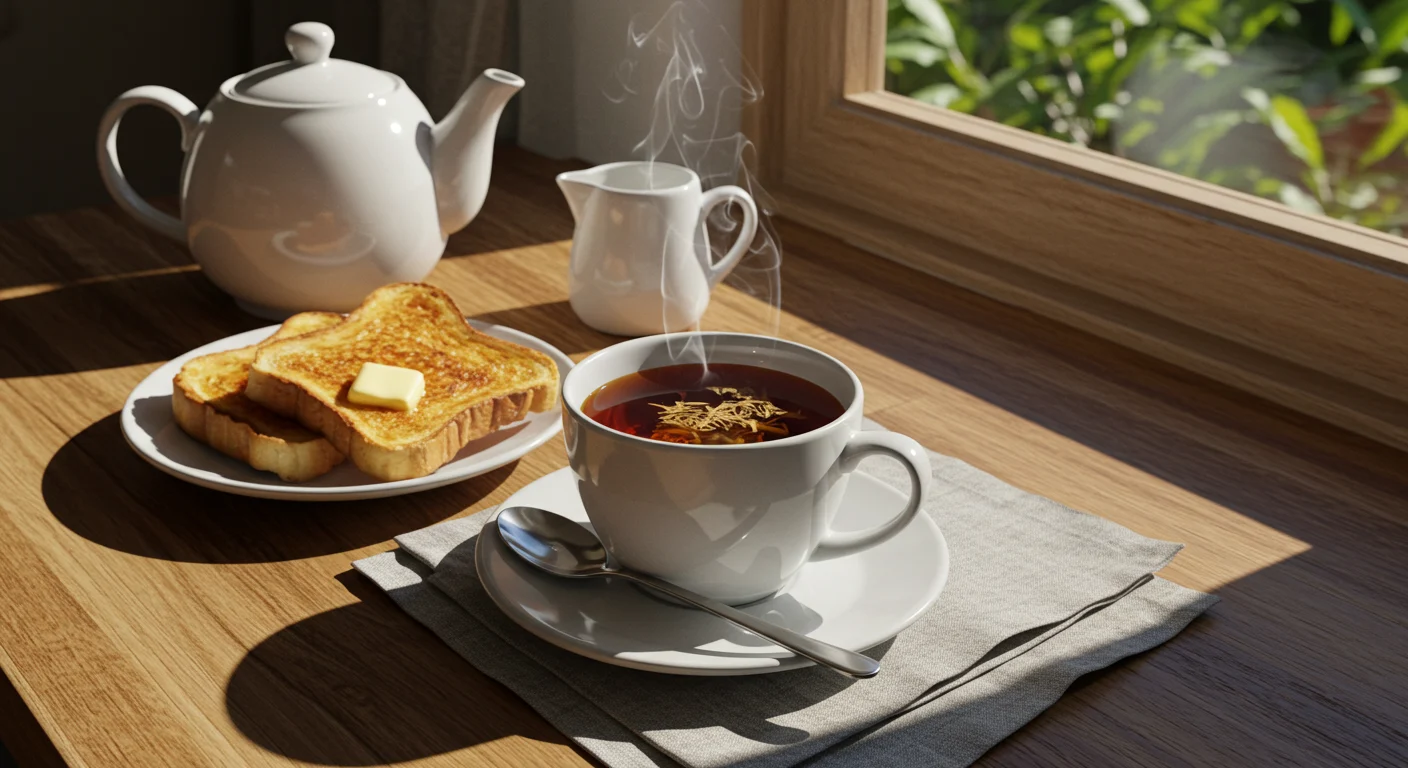When it comes to iconic teas, English Breakfast Tea sits firmly at the top. It’s a staple that combines bold, robust flavours with a rich history, making it a go-to for tea enthusiasts and breakfast lovers alike. Whether brewing a cup to kickstart your morning or relishing a moment of tranquility mid-day, This tea is truly stands as a timeless classic.
But what makes it so special? This blog will explore everything—from its origins and varieties to health benefits and pairing tips. Let’s sip into it!
Listen to the podcast instead ?
Table of Contents
A Brief History of English Breakfast Tea
as the name suggests, has its roots deeply entwined with British culture. However, it wasn’t born in England. Surprisingly, its origins trace back to colonial times. It’s believed that the robust blend gained popularity in Scotland during the 18th century before making its way to England.
According to tea historian Jane Smith, “English Breakfast Tea is a hallmark of British culture, celebrated for its bold flavour and invigorating effect on the day.”
Traditionally, the magical blend consisted of strong Assam leaves, complemented by Ceylon and Kenyan teas. These elements combined to deliver the full-bodied richness we associate with modern English Breakfast Tea today.

How Is English Breakfast Tea Made?
A good English Breakfast Tea is defined by its meticulous blend of high-quality tea leaves. Here’s what typically goes into it:
- Assam Tea: Known for its malty richness, Assam forms the strong base.
- Ceylon Tea: Adds a touch of brightness and citrusy notes.
- Kenyan Tea: Rounds out the blend with its robust and astringent characteristics.
According to Master Blender David Lee, “The secret to a perfect English Tea lies in the blend; it’s a harmonious mix of Assam, Ceylon, and Kenyan teas that creates its distinctive, robust taste.”
Once harvested, the tea leaves undergo a series of processes—like withering, rolling, oxidation, and drying—to develop their unique taste profile.
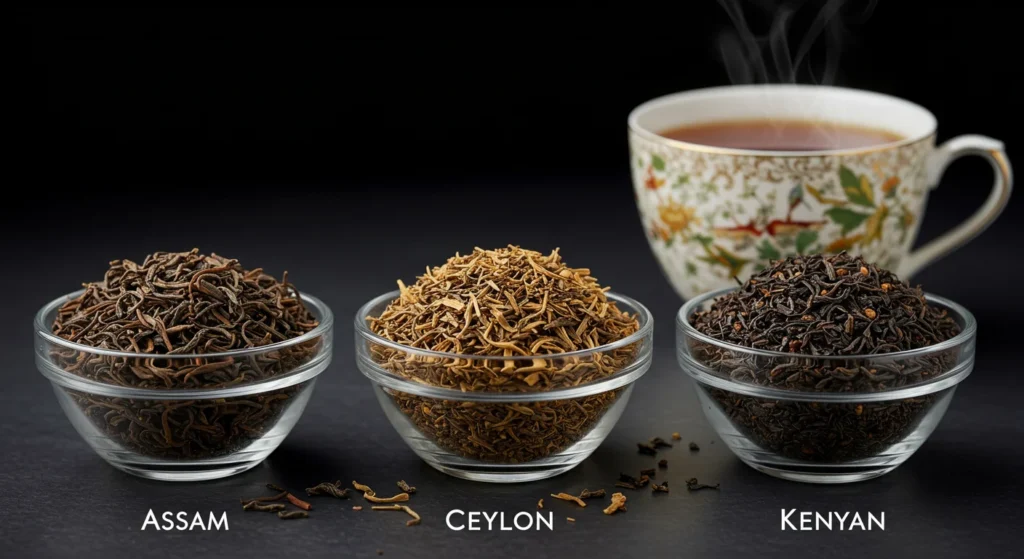
Exploring the Varieties of English Breakfast Tea
Not all Teas are created equal. The chosen leaves and production methods give rise to regional and brand-specific differences.
Regional Blends
- Indian Blends: Heavily reliant on Assam, these teas have a deep, malty flavour.
- Sri Lankan Blends (Ceylon): Expect a lighter, brighter cup with a zesty finish.
- African Blends (Kenyan): Often more robust and earthy, with bold astringent notes.
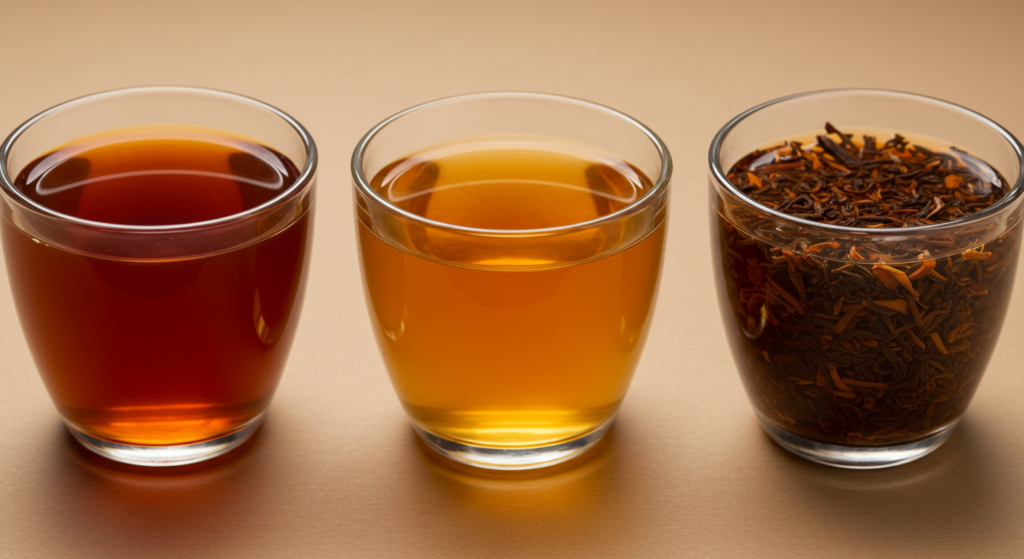
Organic and Decaffeinated Options
Today, many brands also offer organic and decaffeinated varieties to cater to various tastes and lifestyles while maintaining the drink’s quintessential flavor.
Why Choose English Breakfast Tea?
Not only does English Tea satisfy your taste buds, but it’s also packed with health benefits.
According to Dr Emily Chen, a Nutritionist and Tea Enthusiast, “Tea drinkers often overlook the incredible health benefits of this tea from its high antioxidant content to its role in promoting heart health and mental alertness.”
Top Health Benefits
- Rich in Antioxidants: Protects your cells against damage from free radicals.
- Boosts Heart Health: Linked to reduced risks of cardiovascular issues due to its flavonoids.
- Supports Mental Clarity: The moderate caffeine levels can enhance focus while avoiding jitters.
- Improves Digestion: Its tannin content soothes and balances the gut.
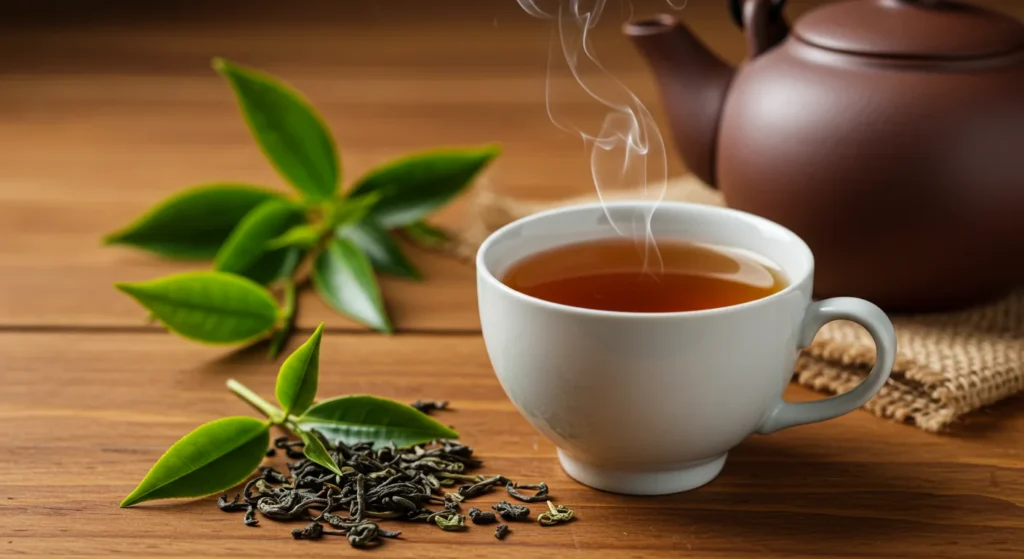
English Breakfast Tea vs. Other Teas
Wondering how English Tea compares to other popular varieties like Earl Grey or green tea? Here’s how it stacks up:
- Earl Grey: While Earl Grey is infused with bergamot oil for a citrusy aroma, English Breakfast is more robust and malty.
- Green Tea: English Breakfast contains higher caffeine than green tea, offering a better kickstart. However, green tea boasts more catechins (antioxidants).
- Irish Breakfast Tea: Irish blends typically lean heavily on malty Assam, making them bolder than English Breakfast.

Brewing the Perfect Cup of English Breakfast Tea
Preparation plays a key role in unlocking the full potential of your tea. Use this simple guide to craft a flawless cup every time.
Brewing Tips
- Choose Fresh Water: Cold, filtered water makes all the difference.
- Measure Properly: Use one teaspoon of tea leaves (or one bag) per cup.
- Optimal Temperature: Heat water to around 95°C (just under boiling).
- Steep Time: Allow the tea to steep for 3–5 minutes, depending on your taste preference.
- Add Milk or Lemon: the tea pairs beautifully with milk, sugar, or even a twist of lemon.
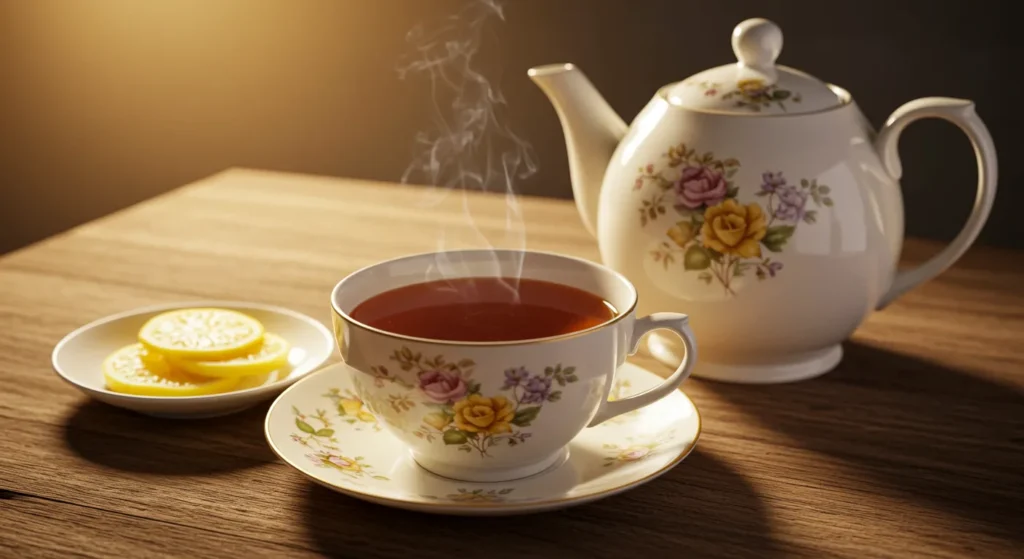
Best Foods to Pair With
- Classic Pairings: Buttered toast, eggs, or a hearty English breakfast.
- Treat Yourself: Tea cakes, scones, or shortbread biscuits.
Ethical and Sustainable Sourcing Practices
With an increasing focus on sustainability, how your tea is sourced matters.
Michael Green, Director of Sustainability at TeasRUs, highlights, “Sustainability in tea production is not just a trend, it’s essential for our environment and the future of tea. Ethical sourcing and fair trade practices are at the core of what makes a great cup of tea.”
Look for products certified by Fair Trade or Rainforest Alliance to support workers’ welfare and eco-friendly farming methods.
Why English Breakfast Tea Will Always Be Timeless
Few things in life remain as constant as the simplicity and comfort of Breakfast Tea. From its rich history to its bold flavours and numerous health benefits, it continues to delight tea lovers every day, all over the world.
If you haven’t already, why not experience the magic yourself?
Try English Breakfast Tea Today!
Feeling inspired to brew your first cup? Grab a pack of high-quality English Breakfast Tea from your favourite store, or browse specialised blends online. Already a fan? Share your go-to English Tea tricks and pairing ideas in the comments section—we’d love to hear from you!
The Future of English Breakfast Tea
As we move forward, the future of English Tea remains bright, with new innovations and trends continuing to shape the way we enjoy this classic beverage. From modern tea blends to creative brewing methods, tea enthusiasts are finding new ways to celebrate and elevate this timeless favorite.
Innovative Trends in Tea Blending
Tea producers are experimenting with fresh, exciting blends by incorporating herbal infusions, floral notes, and spices into traditional English Tea. These innovations aim to enhance the tea’s flavor profile while maintaining its robust and malty essence. Popular additions include hints of lavender, cardamom, or even vanilla, catering to diverse preferences and taste explorations.
Cold Brew and Iced Tea Variations
Many tea drinkers are now enjoying English Tea as a refreshing cold brew or iced tea. By steeping the tea leaves in cold water over several hours, cold brew English Tea delivers a smoother, less astringent flavor profile, perfect for hot summer days. Pair it with a splash of citrus or a touch of honey for a revitalizing twist.
Subscription Services and Personalization
Tea subscription services have gained popularity, allowing consumers to discover new brands and blends of English Breakfast Tea each month. Some companies even offer personalized options, tailoring blends based on individual flavor preferences or health goals. This modern approach ensures that tea lovers always have access to high-quality, curated selections.
Sustainability in Tea’s Future
The focus on sustainability continues to grow, with brands committing to eco-friendly packaging, carbon-neutral production processes, and long-term support for tea-growing communities. By prioritizing ethical practices, the industry is ensuring that English Tea remains a beloved tradition for generations to come.
English Tea is not just a drink; it is a symbol of culture, history, and evolving innovation. With endless possibilities for enjoying it, this cherished tea proves that it can adapt to modern trends while staying true to its classic roots.
Tips for Storing English Breakfast Tea
Proper storage techniques are essential to maintain the freshness and flavor of your English Tea. Here are some practical tips to ensure every cup tastes as good as the first:
- Choose an Airtight Container: Store your tea leaves or bags in an airtight container to protect them from moisture, light, and air exposure. Tin containers or dark glass jars work wonderfully.
- Keep Away from Strong Odors: Tea can easily absorb surrounding smells, so ensure it’s stored away from spices, coffee, or other strong-smelling items in your pantry.
- Store in a Cool, Dry Place: Avoid places with high humidity or direct sunlight, such as near a stove or a window. A kitchen cabinet or dedicated tea box is ideal.
- Avoid Refrigeration: While it may seem counterintuitive, refrigerators can introduce condensation that may degrade the tea’s quality over time.
- Use Fresh Tea Promptly: For the best taste, consume your tea within six months to a year of purchase, as prolonged storage can diminish its rich flavors.
By following these simple storage practices, you can ensure that your English Tea remains aromatic, robust, and ready to deliver the perfect cup each time.
Exploring the Health Benefits of English Breakfast Tea
Beyond its delightful taste, English Tea offers a range of health benefits, making it a fantastic addition to your daily routine.
A Rich Source of Antioxidants
English Tea is packed with antioxidants such as catechins and theaflavins, which help combat oxidative stress in the body. These compounds can support overall health by reducing cell damage and promoting a stronger immune system.
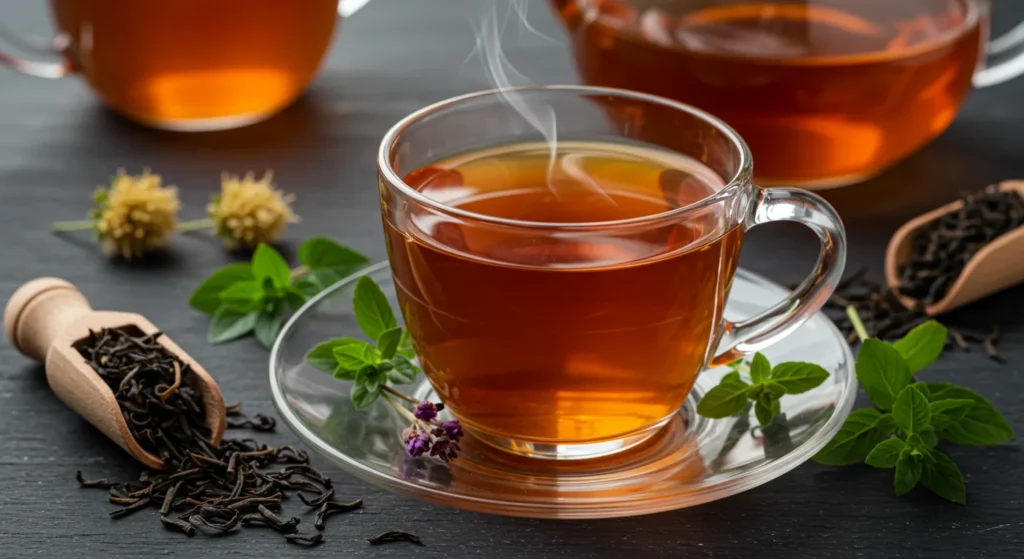
Heart Health Support
Consuming black tea, including English Breakfast Tea, has been linked to improved heart health. Its flavonoids may contribute to lowering bad cholesterol (LDL), reducing blood pressure, and improving overall cardiovascular function when consumed as part of a balanced diet.
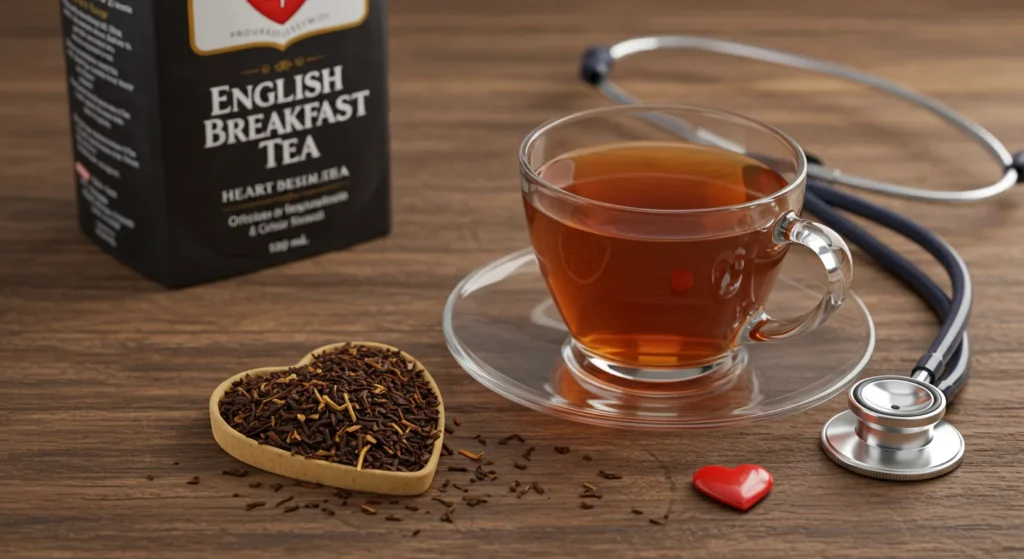
Better Digestion
The tannins in English Breakfast Tea can have a soothing effect on the digestive system, helping to reduce inflammation and providing relief for mild stomach issues. A warm cup of this tea after meals is not only calming but may also support better digestion.
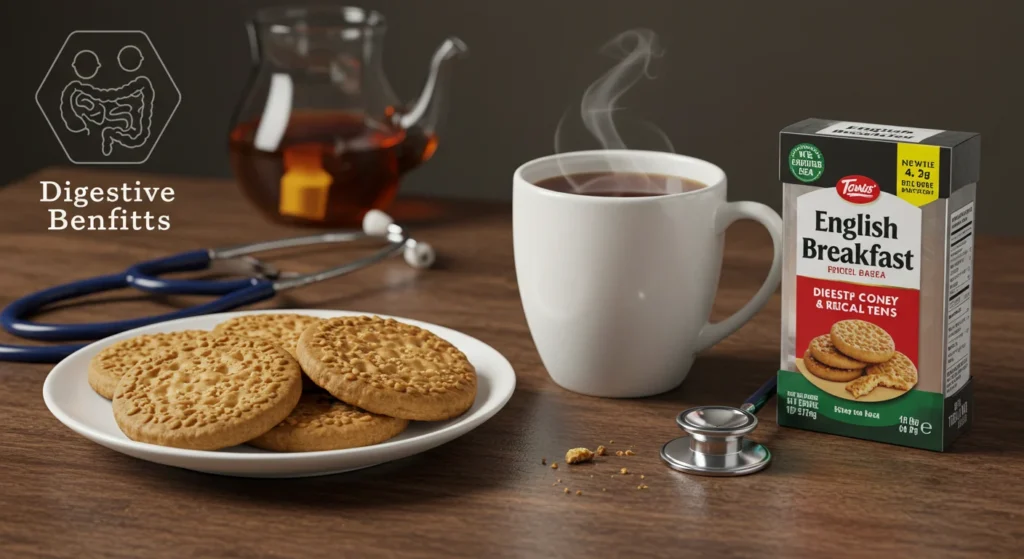
Natural Energy Boost
Thanks to its moderate caffeine content, English Breakfast Tea provides a gentle energy boost without the jitters often associated with coffee. It’s an excellent choice for those seeking an uplift in focus and alertness during the day.
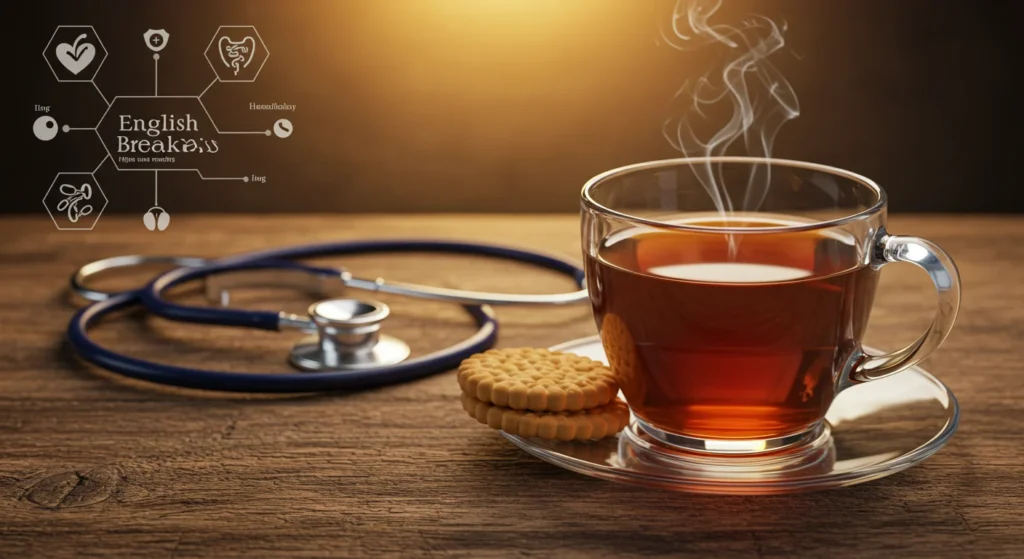
Improved Mental Clarity
L-theanine, an amino acid found in black tea, works synergistically with caffeine to promote mental clarity, concentration, and even relaxation. This unique combination makes English Breakfast Tea a great companion for work, study, or creative pursuits.
By including English Tea in your routine, you can enjoy both its rich, comforting flavors and its numerous health advantages, contributing to a healthier and more balanced lifestyle.
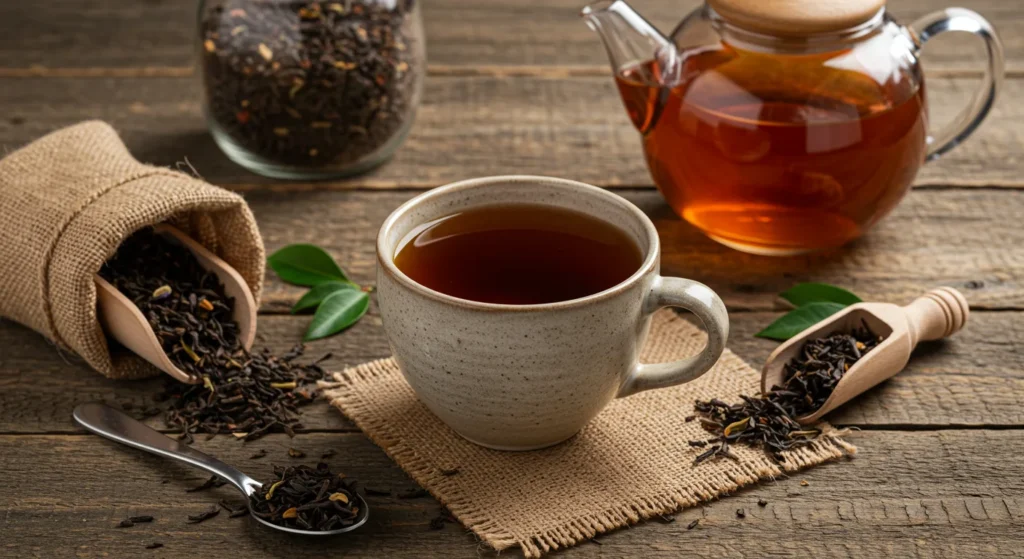
Pairing English Breakfast Tea with Food
English Breakfast Tea is renowned for its versatility and pairs beautifully with a variety of foods, making it an excellent choice for meals or snacks throughout the day.
Breakfast and Brunch Combos
True to its name, English Breakfast Tea is a natural companion for hearty breakfast dishes. Its robust flavor complements classics such as eggs, toast, and bacon, or a traditional full English breakfast. For a lighter option, try pairing it with buttery croissants, flaky pastries, or fruit-based dishes like berry parfaits. Its malty notes provide a satisfying contrast to the sweetness of these dishes.
Afternoon Tea Delights
When it comes to the quintessential afternoon tea experience, English Breakfast Tea is the star. Its bold flavor holds up well against rich desserts like scones with clotted cream and jam, Victoria sponge cake, and shortbread biscuits. Savory tea sandwiches, filled with cucumber, smoked salmon, or egg salad, are also enhanced by this tea’s balanced profile.
Savory Dinners
At dinner time, English Breakfast Tea can act as an unexpected yet delightful pairing for savory dishes. Its tannins balance rich, meaty meals like roast beef or lamb, while its earthy notes complement vegetarian options like stuffed mushrooms or lentil stews. Using the tea as an ingredient in marinades or sauces can also add depth to your culinary creations.
Sweet Indulgences
For those with a sweet tooth, English Breakfast Tea is the perfect match for chocolate desserts, such as brownies, truffles, or dark chocolate fondue. Its slight astringency cuts through the richness of chocolate, offering a balanced and satisfying indulgence.
Exploring food pairings with English Breakfast Tea opens up a world of culinary possibilities, ensuring that every sip and every bite is a delight. Whether enjoyed in the morning, afternoon, or evening, this versatile tea enhances the flavors of your favorite meals and treats.
Frequently Asked Questions (FAQs)
1. What makes English Breakfast Tea unique?
English Breakfast Tea is known for its rich, full-bodied flavor and robust character. It is traditionally made from a blend of black teas, such as Assam, Ceylon, and Kenyan teas, which together create its distinctive strength and malty notes, making it an ideal choice for pairing with food or enjoying on its own.
2. Can English Breakfast Tea be enjoyed without milk?
Absolutely! While it is commonly enjoyed with milk, English Breakfast Tea can be just as delightful on its own or with a slice of lemon. Its bold flavors hold up well without any additives, allowing you to savour the natural complexity of the blend.
3. How should I store English Breakfast Tea?
To maintain its freshness and flavour, store English Breakfast Tea in an airtight container, away from direct sunlight, moisture, and strong odours. A cool, dry place like a pantry is ideal.
4. Is English Breakfast Tea caffeinated?
Yes, English Breakfast Tea contains caffeine, making it a popular choice for mornings or as an energy boost during the day. If you are sensitive to caffeine, you may opt for a decaffeinated version, which still offers a satisfying flavour.
5. Can I use English Breakfast Tea in cooking or baking?
Absolutely! English Tea can be used as an ingredient to infuse flavour into recipes. Try brewing it as a base for soups, sauces, or marinades, or incorporate it into cakes and biscuits for a unique twist.
6. How should I brew the perfect cup of English Tea?
For the best results, use freshly boiled water and steep the tea for 3-5 minutes, depending on your preference for strength. Add milk, sugar, or lemon to taste, or enjoy it plain to appreciate its bold flavour.
Certainly! Here’s a Resources section tailored for your blog post on English Breakfast Tea. This section provides your readers with valuable references to further explore and deepen their understanding of the topic.
Resources for English Breakfast Tea
Books
- The Story of Tea: A Cultural History and Drinking Guide by Mary Lou Heiss and Robert J. Heiss
A comprehensive guide exploring the history, culture, and varieties of tea, including detailed sections on English Breakfast Tea. - Tea: History, Terroirs, Varieties by Kevin Gascoyne, Francois Marchand, and Jasmin Desharnais
Delves into the origins, cultivation, and different types of tea, with a focus on black teas like English Breakfast. - The Tea Book: All Things Tea by Louise Cheadle and Nick Kilby
Covers various aspects of tea, including preparation methods, health benefits, and tea etiquette.
Websites
- Twinings Official Website
As one of the original creators of English Breakfast Tea, Twinings offers extensive information about their blends, history, and brewing tips. - The Tea Association of the USA
Offers a wealth of information on different types of tea, industry news, and educational resources. - Teavivre’s Tea Encyclopedia
Comprehensive guides on various teas, including English Breakfast Tea, with detailed descriptions and brewing instructions.
Articles and Blogs
- “The History of English Breakfast Tea” by Tea Drunk
An in-depth exploration of the origins and evolution of English Breakfast Tea. - “How to Brew the Perfect English Breakfast Tea” by Teavivre
Step-by-step guide on brewing English Breakfast Tea to achieve the best flavor. - “English Breakfast Tea: Benefits and Brewing Tips” by Healthline
Discusses the health benefits and provides brewing recommendations for English Breakfast Tea.
Scientific Studies
- “Antioxidant Properties of Black Tea” – Available on PubMed
Research on the antioxidant content and health benefits of black teas, including English Breakfast. - “Effects of Tea Consumption on Cardiovascular Health” – Published in The American Journal of Clinical Nutrition
Studies the impact of regular tea consumption on heart health.
Videos and Documentaries
- “The History of English Breakfast Tea” by Tea Drinker (YouTube Channel)
A visual exploration of the origins and cultural significance of English Breakfast Tea. - “How to Brew the Perfect Cup of English Breakfast Tea” by The Tea Spot (YouTube Channel)
Tutorial on brewing techniques to enhance the flavor of English Breakfast Tea.
Online Forums and Communities
- Reddit’s r/tea
A community of tea enthusiasts discussing various teas, including English Breakfast Tea. - TeaChat Forum
A forum dedicated to tea lovers, covering topics from brewing methods to tea reviews.
Additional Resources
- Google Scholar
Access a wide range of academic papers and articles on English Breakfast Tea for in-depth research. - YouTube Educational Channels
Channels like “The Tea Spot,” “Tea Drinker,” and “Sweet Leaf Tea” often post informative videos about different teas.

